
When I first started reading food blogs, the Darling Bakers were on Dorie's perfect party cake. After all the raving about this cake, I became interested in her recipes and started to follow the bloggers of Tuesdays With Dorie. 3 months later, I finally ordered my copy after getting over the worry that I would receive one with the edges bent or a scratch down the middle. The book finally arrived, but then came the problem of choosing the first recipe to try. The devils food white out cake on the cover looked so delicious and beautiful I decided to start off with the layer cake. Having read the chocolate cake recipes by Cook's Illustrated, I couldn't help but compare the ingredients and mixing methods. Cook's claim that adding the boiling water to the cocoa would deepen the flavour, but in this recipe the boiling water was added last. I decided that this time I would just stick to the recipe completely, which is actually a lot harder than it sounds.
Luckily, Dorie left a note saying that the butter/sugar/egg mixture would curdle because I got really worried when the beautiful emulsion of fat and sugar broke and started to clump. As soon as the melted chocolate was added, the mixture magically came together and was smooth and silky. I didn't have 8x2 inch pans so I divided the batter into 3 8x1.5 inch pans. Usually I get a whole lot of doming so I was planning on getting the crumbs from the cake shavings. This time, the cakes came out pretty flat so I only had enough crumbs to make a small pile on top.
While most people believe that a cake is a vehicle for frosting, I have yet to find a frosting other than whipped cream that I truly love. I actually love eating cake for cake and usually find myself scraping the frosting off. As much as I wish I could love buttercream, I just can't get past that feeling of eating a stick of butter. The Italian merangue frosting on this cake was very light and fluffy, a perfect balance for the rich layers. Despite its lightness, I went easy on the frosting and didn't even frost the outside, a tendency of mine.
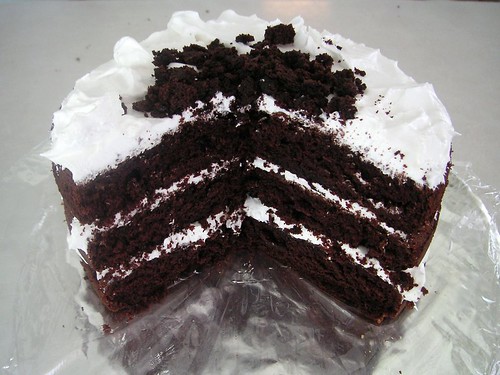
The cake was fluffy, not greasy, moist, yet sturdy enough to slice cleanly. It also had the perfect amount of richness, unlike recipes that leave your feeling like you've just eaten a frosted brownie. This was definitely the best chocolate cake I've ever made, even better than Epicurious' double chocolate cake. The Epicurious cake is also very moist and fluffy, but lacked the density of a cake made with butter. I think I could have eaten the whole cake myself, but I fell into a sugar coma after my huge slice. Luckily I still had one slice left for breakfast!
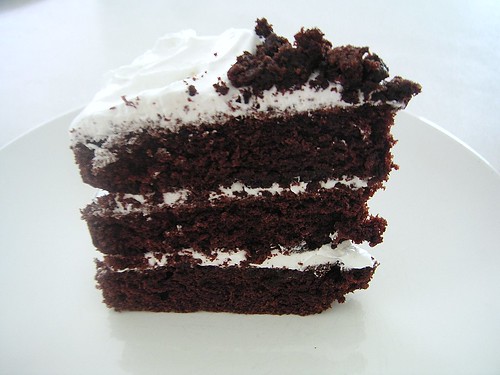
Dorie Greenspan, Baking: From My Home to Yours
Makes makes 12 servings
For the cake
1 1/3 cups all-purpose flour
1/2 cup unsweetened cocoa powder
3/4 teaspoon baking soda
1/2 teaspoon baking powder
1/4 teaspoon salt
1 1/4 sticks (10 tablespoons) unsalted butter, at room temperature
1/2 cup (packed) light brown sugar
1/2 cup sugar
3 large eggs, at room temperature
1 teaspoon pure vanilla extract
2 ounces bittersweet chocolate, melted and cooled
1/2 cup buttermilk or whole milk, at room temperature
1/2 cup boiling water
4 ounces semisweet or milk chocolate, finely chopped, or 2/3 cup store-bought mini chocolate chips
For the filling and frosting
1/2 cup egg whites (about 4 large)
1 cup sugar
3/4 teaspoon cream of tartar
1 cup water
1 tablespoon pure vanilla extract
GETTING READY: Center a rack in the oven and preheat the oven to 350 degrees F. Butter two 8-x-2-inch round cake pans, dust the insides with flour, tap out the excess and line the bottoms with parchment or wax paper. Put the pans on a baking sheet.
TO MAKE THE CAKE: Sift together the flour, cocoa, baking soda, baking powder and salt.
Working with a stand mixer, preferably fitted with a paddle attachment, or with a hand mixer in a large bowl, beat the butter on medium speed until soft and creamy. Add the sugars and continue to beat for another 3 minutes. Add the eggs one by one, beating for 1 minute after each addition. Beat in the vanilla; don't be concerned if the mixture looks curdled. Reduce the mixer speed to low and mix in the melted chocolate. When it is fully incorporated, add the dry ingredients alternately with the buttermilk, adding the dry ingredients in 3 additions and the milk in 2 (begin and end with the dry ingredients); scrape down the sides of the bowl as needed and mix only until the ingredients disappear into the batter. At this point, the batter will be thick, like frosting. Still working on low speed, mix in the boiling water, which will thin the batter considerably. Switch to a rubber spatula, scrape down the bowl and stir in the chopped chocolate. Divide the batter evenly between the two pans and smooth the tops with the rubber spatula.
Bake for 25 to 30 minutes, rotating the pans at the midway point. When fully baked, the cakes will be springy to the touch and a thin knife inserted into the centers will come out clean. Don't worry if the tops have a few small cracks. Transfer the cake pans to a rack and cool for about 5 minutes, then run a knife around the sides of the cakes, unmold them and peel off the paper liners. Invert and cool to room temperature right side up. (The cooled cake layers can be wrapped airtight and stored at room temperature overnight or frozen for up to 2 months.)
When you are ready to fill and frost the cake, inspect the layers. If the cakes have crowned, use a long serrated knife and a gentle sawing motion to even them. With the same knife, slice each layer horizontally in half. Set 3 layers aside and crumble the fourth layer; set the crumbs aside.
TO MAKE THE FILLING AND FROSTING: Put the egg whites in a clean, dry mixer bowl or in another large bowl. Have a candy thermometer at hand.
Put the sugar, cream of tartar and water in a small saucepan and stir to combine. Bring the mixture to a boil over medium-high heat, cover the pan and boil for 3 minutes. Uncover and allow the syrup to boil until it reaches 242 degrees F on the candy thermometer. While the syrup is cooking, start beating the egg whites.
When the syrup is at about 235 degrees F, begin beating the egg whites on medium speed with the whisk attachment or with a hand mixer. If the whites form firm, shiny peaks before the syrup reaches temperature, reduce the mixer speed to low and keep mixing the whites until the syrup catches up. With the mixer at medium speed, and standing back slightly, carefully pour in the hot syrup, pouring it between the beater(s) and the side of the bowl. Splatters are inevitable -- don't try to scrape them into the whites, just carry on. Add the vanilla extract and keep beating the whites at medium speed until they reach room temperature, about 5 minutes. You should have a smooth, shiny, marshmallowy frosting. Although you could keep it in the fridge in a pinch, it's really better to use it right now.
TO ASSEMBLE THE CAKE: Put a bottom layer cut side up on a cardboard cake round or on a cake plate protected by strips of wax or parchment paper. Using a long metal icing spatula, cover the layer generously with frosting. Top with a second layer, cut side up, and frost it. Finish with the third layer, cut side down, and frost the sides and top of the cake. Don't worry about smoothing the frosting -- it should be swirly. Now, cover the entire cake with the chocolate cake crumbs, gently pressing the crumbs into the filling with your fingers.
Refrigerate the cake for about 1 hour before serving. (If it's more convenient, you can chill the cake for 8 hours or more; cover it loosely and keep it away from foods with strong odors.)
SERVING: I think the cake is best at room temperature or just cool, but many people prefer it cold (the texture of the cake becomes fudgier after it has been refrigerated). No matter the temperature, the cake is so pretty it should be cut at the table, so bring it out on a platter and cut it into generous wedges using a serrated knife and a sawing motion.
STORING: The frosted cake can be stored in the refrigerator for up to 2 days; let it stand at room temperature for 30 minutes before serving, or longer if you have the time.
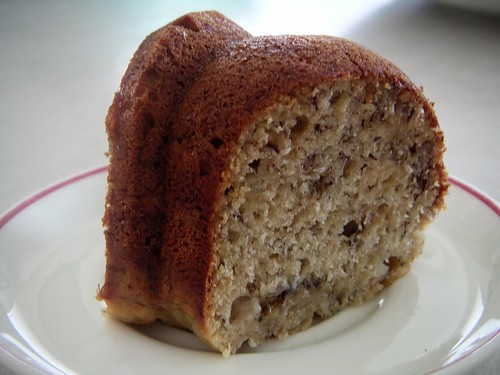


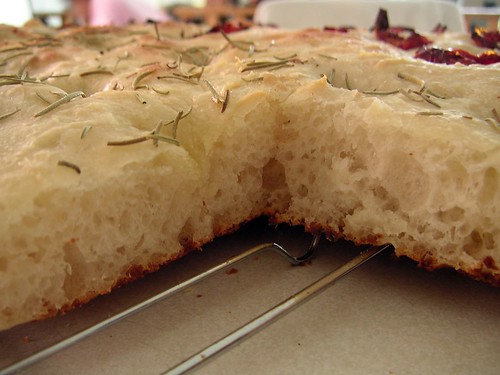
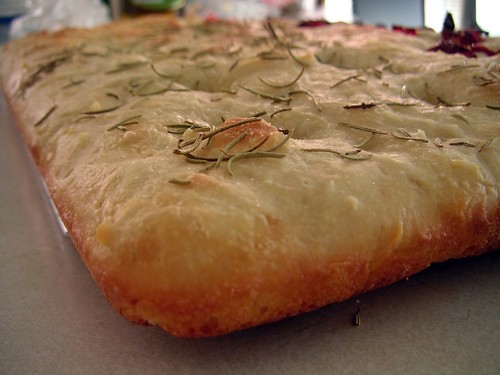


.JPG)
.JPG)




